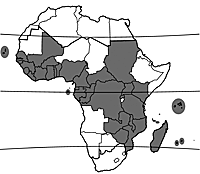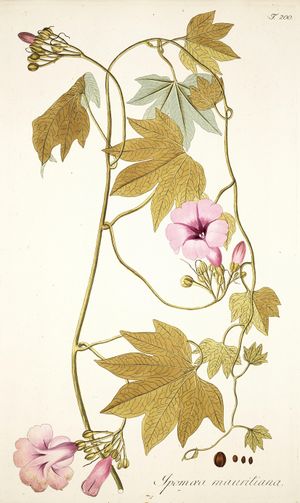Ipomoea mauritiana (PROTA)
Introduction |
| General importance | |
| Geographic coverage Africa | |
| Geographic coverage World | |
| Medicinal | |
| Ornamental | |
| Forage / feed | |
Ipomoea mauritiana Jacq.
- Protologue: Collectanea 4: 216 (1791).
- Family: Convolvulaceae
- Chromosome number: 2n = 30
Synonyms
- Ipomoea paniculata (L.) R.Br. (1810).
Vernacular names
- Giant potato, Natal cotton plant, giant forest ipomoea, palmate morning glory (En).
Origin and geographic distribution
The origin of Ipomoea mauritiana is uncertain. It is originally described from herbarium material from Mauritius, but is now present throughout the tropics and subtropics. It is recorded from most countries of tropical Africa, and also in South Africa.
Uses
A decoction of the roots and leaves is widely taken to treat diarrhoea, as a purgative and diuretic. In Senegal a maceration of the powdered roots is also taken as an abortifacient, while an extract of the root is taken as galactagogue. In Côte d’Ivoire a decoction of the dried roots is administered as enema to treat kidney-pains, female sterility, and to ensure a good pregnancy and to avoid miscarriages. In Benin a decoction of the leaves, together with those of Croton lobatus L., is given to babies with colic, while a decoction of leafy twigs is given to strengthen emaciated children. A maceration of the roots, together with those of Ampelocissus bombycina (Baker) Planch., is drunk to treat oedema. In DR Congo ground young shoots are applied to immature gangrenous and necrotic ulcers. In Gabon the ground tuberous roots macerated in water are used as a wash against venereal diseases. In Nigeria a root decoction is taken as an alterative and aphrodisiac tonic. The root, mixed with palm wine, is considered galactagogue.
In India the tuberous roots are considered high value in traditional medicine. They are used in many formulations with other plants, but also as single drug. Different preparations are taken as an aphrodisiac, cardiotonic, demulcent, diuretic, refrigerant, galactagogue and general tonic. They are used against emaciation, enteric fever and spermatorhoea.
In India the seeds have been used to coagulate milk. In Senegal and India the plant is browsed by cattle. The plant is occasionally grown as an ornamental.
Production and international trade
Ipomoea mauritiana is an important item in trade in parts of continental Asia. In Africa it is probably of local importance only.
Properties
The methanol extract of the tuberous roots contains taraxerol, taraxerol acetate, β-sitosterol, scopoletin and 7-O-β-D-glucopyranosyl scopoletin (scopolin). The root also contains umbelliferone. The root of Indian material has been reported to contain 1.3% of an oil consisting of glycerides of oleic acid (60%), linoleic acid (19%), palmitic acid (8%) and linolenic acid (1%). The seeds contain a gum that may be useful in the preparation of drugs. Starch grains from the seeds are irregular in size and the starch induces less viscosity in water than potato starch.
The tuber root powder, when administered to diets of rats for 28 days, caused dose-dependent and significant lowering of serum total cholesterol and triglycerides. It also led to dose-dependent significant elevations in level of serum high density lipoprotein (HDL)-cholesterol. A significant lowering of serum glucose level and serum low density lipoprotein (LDL)-cholesterol was further observed at the various doses of the powder (0.01, 0.033 and 0.1% w/w diet). The results indicate that regular intake of tuber root powder can be of beneficial use to persons suffering from or prone to coronary disease problems and diabetes.
In India phytochemical and microscopy protocols and standards have been developed that can be used in quality control of the crude tuberous root powder of Ipomoea mauritiana. Analyses of the methanol extracts showed 0.029–0.034% scopoletin. Characteristic microscopic features of tubers of Ipomoea mauritiana include the presence of cluster crystals, simple and compound starch grains with a range of 10–50 μm and orange-brown cell fragments of latex channels.
A screening test in India showed that Ipomoea mauritiana has relatively strong antifungal activity against Rhizoctonia solani.
Description
Large, glabrous, perennial liana with large tuberous roots; stems twining, occasionally prostrate, terete. Leaves alternate; petiole 3–11 cm long; blade circular in outline, entire or palmately 3–9-lobed, 6–24 cm × 6–18 cm, base cordate or truncate, lobes lanceolate to ovate with acuminate apex. Inflorescence an axillary, few- to many-flowered cyme; peduncle up to 20 cm long. Flowers bisexual, regular, 5-merous; flower-buds globular; pedicel 1–2.5 cm long; sepals markedly convex, clasping the corolla-tube, orbicular or elliptical, 6–12 mm long; corolla funnel-shaped, with the tube narrow below, 5–7 cm long, spreading at apex, more or less 5-lobed, 6–9 cm in diameter, pink to reddish-purple with darker centre; stamens included; ovary superior, style slender, stigma capitate. Fruit an ovoid capsule 1.2–1.4 cm long, 4-seeded. Seeds 6–7 mm long, black, covered with c. 7 mm long silky hairs. Seedling with epigeal germination.
Other botanical information
Ipomoea is a large and complex genus containing 500–600 species of vines and shrubs, widely distributed throughout the tropics and subtropics. Ipomoea mauritiana has been placed taxonomically in subgenus Eriospermum, section Eriospermum, in which Ipomoea batatas (L.) Lam. is also placed. Several other Ipomoea spp. are medicinally used in Madagascar and tropical Africa.
Ipomoea desmophylla
Ipomoea desmophylla Bojer ex Choisy is a small liana endemic to Madagascar and occurring in dry localities in grass, rocky areas or woodland, from sea-level up to 2500 m altitude. The tubers are purgative if eaten in large quantities, but despite this they are eaten during times of food shortage. The aerial parts provide a good fodder.
Ipomoea longituba
Ipomoea longituba Hallier f. is a small shrub with sprawling branches from Kenya, Uganda, Tanzania and Madagascar. An infusion of the tuber is taken by women in Tanzania to increase milk production. Throughout East Africa a tuber infusion is given to cattle to increase milk production and as a laxative. A tuber poultice is applied to ticks. Tubers are also cooked and eaten as food.
Ipomoea rubens
Ipomoea rubens Choisy is a large perennial liana, widespread in tropical Africa, the Indian Ocean islands, South-East Asia and South America. In West Africa crushed leaves are applied to snakebites or rubbed on the whole body. A leaf maceration is used for bathing to prevent miscarriages, to treat eclampsia and as post-partum care. A leaf decoction is used as a wash for syphilitic sores, and for teething children. Root powder is eaten to treat sexual asthenia.
Ipomoea verbascoidea
Ipomoea verbascoidea Choisy is a small woolly-hairy shrub, occurring in West and southern Africa and in Madagascar. In Zimbabwe and Namibia a root infusion or root pulp boiled in milk is given to babies with lack of appetite to fatten them. A porridge made from the tubers is taken to treat infertility of women.
Ipomoea wightii
Ipomoea wightii (Wall.) Choisy is a perennial herb with twining or prostrate stems from Sudan and Ethiopia southward to South Africa and Madagascar, but also in tropical Asia. In DR Congo the ash of burned plants is applied to the skin to treat leprosy. In Rwanda leaf extracts are taken to treat liver complaints and roots have been used in mixtures in the preparation of arrow poison, whereas in East Africa root preparations are taken against cough and leaf decoctions against stomach-ache. In Ethiopia plants are locally collected to serve as forage.
Growth and development
Flowers of Ipomoea mauritiana are open and available to visiting insects for a very short time. In beach vegetation in Brazil, anthesis occurs between 5:30 a.m. and 6:00 a.m. and by 11:00 a.m. flowers are completely closed.
Ecology
Ipomoea mauritiana grows in dense and open forest, in riparian woodland, savanna with trees, dwarf forest near seashores, on river banks and in swamps, often on sandy soils, from sea-level up to 2500 m altitude. It is also found in waste places and in plantations of Tectona and Gmelina.
Propagation and planting
Ipomoea mauritiana is propagated by seeds. Protocols have been developed in India for the micropropagation of plant material for medicinal purposes.
Genetic resources
Ipomoea mauritiana is widespread, common and sometimes weedy; it is in no danger of genetic erosion.
Prospects
Ipomoea mauritiana is likely to remain a useful laxative, but its other medicinal uses have to be studied extensively before an assessment of its potential can be made. An assessment of its toxicity is also needed for safe use.
Major references
- Burkill, H.M., 1985. The useful plants of West Tropical Africa. 2nd Edition. Volume 1, Families A–D. Royal Botanic Gardens, Kew, Richmond, United Kingdom. 960 pp.
- Dharmaratne, H.R.W., Jayasinghe, U.L.B., Weerawardhena, W.D.P.P., Herath, H. M.T.B. & Fujimoto, Y., 1997. Chemical investigatio n of Ipomoea mauritiana. ACGC Chemical Research Communications 6: 39–41.
- Moushumi, S.J., Ahmed, R., Ahmed, H., Ali, M., Haq, W.M., Jahan, R. & Rahmatullah, M., 2010. Hypoglycemic, hypocholesterolemic and hypotriglyceridemic activity of tuber roots of Ipomoea mauritiana Jacq. (Convolvulaceae) when administered to rats. Advances in Natural and Applied Sciences 4(2): 174–176.
- Neuwinger, H.D., 2000. African traditional medicine: a dictionary of plant use and applications. Medpharm Scientific, Stuttgart, Germany. 589 pp.
- Verdcourt, B., 1963. Convolvulaceae. In: Hubbard, C.E. & Milne-Redhead, E. (Editors). Flora of Tropical East Africa. Crown Agents for Oversea Governments and Administrations, London, United Kingdom. 161 pp.
Other references
- Adjanohoun, E.J., Adjakidjè, V., Ahyi, M.R.A., Aké Assi, L., Akoègninou, A., d’Almeida, J., Apovo, F., Boukef, K., Chadare, M., Cusset, G., Dramane, K., Eyme, J., Gassita, J.N., Gbaguidi, N., Goudote, E., Guinko, S., Houngnon, P., Lo, I., Keita, A., Kiniffo, H.V., Kone-Bamba, D., Musampa Nseyya, A., Saadou, M., Sodogandji, T., De Souza, S., Tchabi, A., Zinsou Dossa, C. & Zohoun, T., 1989. Contribution aux études ethnobotaniques et floristiques en République Populaire du Bénin. Agence de Coopération Culturelle et Technique, Paris, France. 895 pp.
- Baerts, M. & Lehmann, J., 2013. Ipomoea longituba. [Internet]. Prelude Medicinal Plants Database. Metafro-Infosys, Royal Museum for Central Africa, Tervuren, Belgium. http://www.metafro.be/prelude. Accessed January 2013.
- Boiteau, P., Boiteau, M. & Allorge-Boiteau, L., 1999. Dictionnaire des noms malgaches de végétaux. 4 Volumes + Index des noms scientifiques avec leurs équivalents malgaches. Editions Alzieu, Grenoble, France.
- Chandrakala, S., Karthik, C. & Venkatasubramanian Padma, 2009. Phytochemical and microscopic analysis of tubers of Ipomoea mauritiana Jacq. (Convolvulaceae). Pharmacognosy Magazine 5(19): 272–278.
- Geetha, S.P., Raghu, A.V., Martin, G., George, S. & Balachandran, I., 2009. In vitro propagation of two tuberous medicinal plants: Holostemma ada-kodien and Ipomoea mauritiana. Methods in molecular biology 547: 81–92.
- Gurib-Fakim, A., Guého, J. & Bissoondoyal, M.D., 1995. Plantes médicinales de Maurice, tome 1. Editions de l’Océan Indien, Rose-Hill, Mauritius. 495 pp.
- Joseph, A., Skaria, B.P., Mathew, S., Joy, P.P. & Mathew, G., 2008. Giant potato - an under exploited medicinal plant. Indian Journal of Arecanut, Spices and Medicinal Plants 10(1): 8–12.
- Patankar, M.P. & Mulla, R.M., 2004. Starch from tubers of Ipomoea mauritiana Jacq. Journal of Economic and Taxonomic Botany 28(1): 65–70.
- Tiwari, R.K.S., Singh, A., Das, K. & Sinha, A., 2007. Efficacy of extracts of medicinal plants against Rhizoctonia solani. Annals of Plant Protection Sciences 15(2): 499–501.
- Vidya, D. & Shreeda, A., 2011. Comparison of HPLC and HPTLC techniques for determination of umbelliferone from dried tuber powder of Ipomoea mauritiana Jacq. International Journal of Pharmaceutical Sciences and Research 2(11): 2894–2900.
Author(s)
- M. Lamidi, Institut de Pharmacopée et de Médecine Traditionnelle (IPHAMETRA, CENAREST), B.P. 842, Libreville, Gabon
Correct citation of this article
Lamidi, M., 2013. Ipomoea mauritiana Jacq. In: Schmelzer, G.H. & Gurib-Fakim, A. (Editors). Prota 11(2): Medicinal plants/Plantes médicinales 2. PROTA, Wageningen, Netherlands. Accessed 18 December 2024.
- See this page on the Prota4U database.


